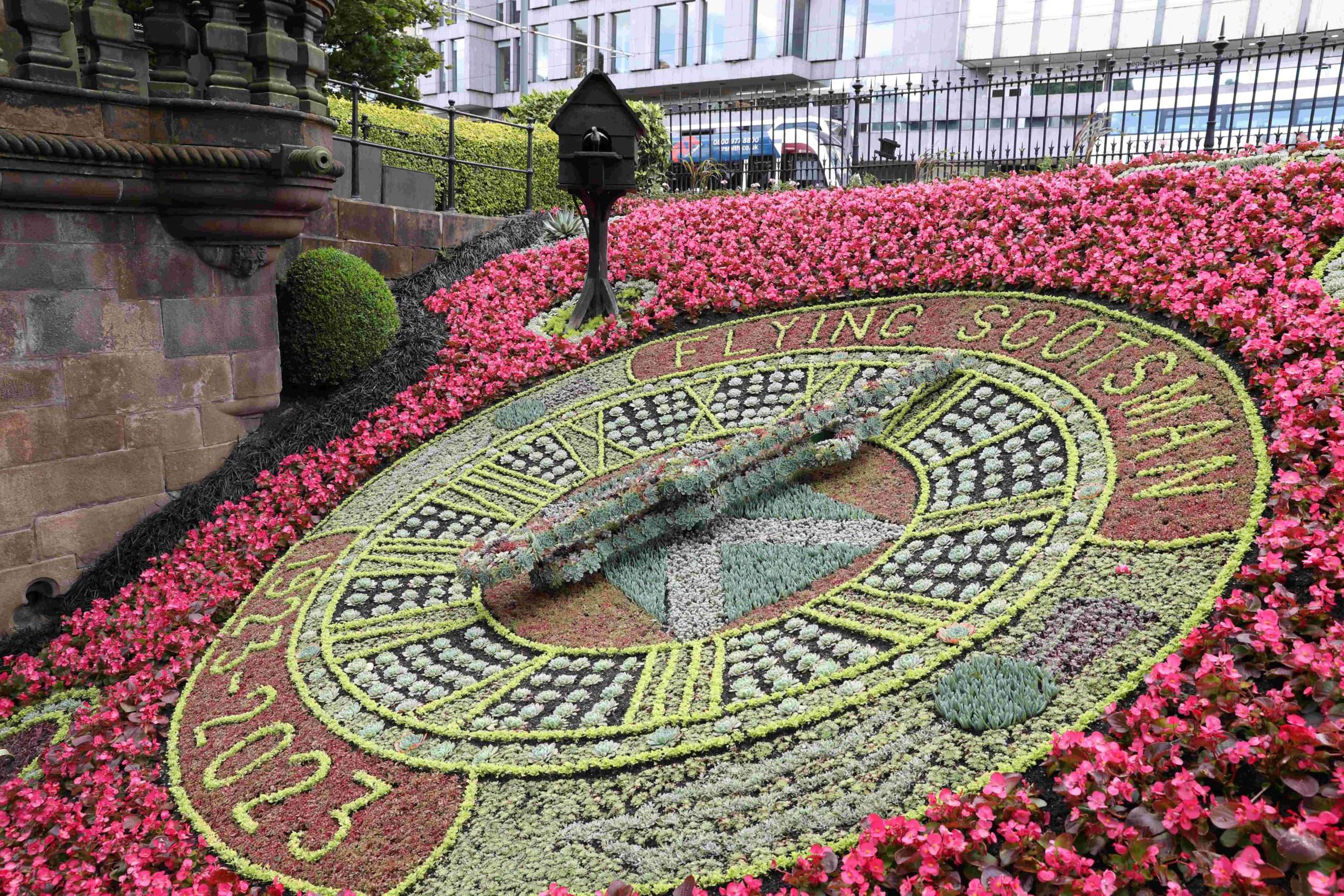Work has finished to complete this year’s design on the world’s oldest Floral Clock in Edinburgh’s West Princes Street Gardens. For 2023, the hugely popular landmark will celebrate 100 years of Flying Scotsman, the world’s most famous steam locomotive. A team of three gardeners took just four weeks to plant over 50,000 flowers and plants used to create the clock, which will be in bloom until October. There are 20 different plants included in this year’s design such as antennaria, crassula, echevaria, sedum, saxifrage and annuals such as pyrethrum, begonias and geraniums.
The dedication of the clock coincided with a visit to the Capital from the iconic locomotive. The Lord Provost Robert Aldridge was joined by floral clock gardeners Gillian and David to welcome Flying Scotsman at Edinburgh Waverley. Edinburgh’s Lord Provost Robert Aldridge said: “I am delighted to once again see the city’s beautiful floral clock completed, and blooming in time for the special visit from Flying Scotsman. Each year the iconic clock marks special occasions and events in the heart of the Capital and this year it is a unique tribute coinciding with celebrations taking place around the country to celebrate 100 years of Flying Scotsman. My thanks and congratulations to the dedicated and creative parks team who have put together the design that I’m sure will be enjoyed by everyone who passes by it this summer.”
The oldest of its kind in the world

Edinburgh born Andrew McLean, National Railway Museum Assistant Director and Head Curator, said: “I first saw the clock when I was a boy and my grandfather was involved in helping maintain it as part of his job as the Clerk of Works for the City of Edinburgh Council from the late 1940s until the early 1980s. It is an important part of Edinburgh’s history and was always a source of great pride so bringing the clock and Flying Scotsman together is a great joy for me.”
The Floral Clock was first created in 1903 by then Edinburgh Parks Superintendent, John McHattie, and is the oldest of its kind in the world. It initially operated with just an hour hand, with a minute hand added in 1904, followed by a cuckoo clock in 1952. Until 1972 the clock was operated mechanically and had to be wound daily. Since 1946 it has been designed in honour of various organisations and individuals, including the Girl Guides Association, Robert Louis Stevenson and the Queen, for her Golden Jubilee. In the clock’s centenary year in 2003 it won a Gold Medal at the RHS Chelsea Flower Show.
Flying Scotsman, the world’s most famous steam locomotive, turned 100 in February 2023. Synonymous with the golden age of rail travel, the locomotive is renowned as a feat of design and engineering. It is a star attraction in the collection of the National Railway Museum (part of the Science Museum Group) in York, where it is a working museum exhibit
Did you know?
Floral Clock
-The clock was created in 1903 and is the oldest floral clock in the world.
-It is housed in the plinth of the Allan Ramsay Monument at the north-east corner of West Princes Street Gardens.
-Planting begins in May each year.
-Up to 50,000 plants are used in the design each year (compared to 13,000 in the 1930s; 25,000 in the 1950s).
-In 1946 the clock began celebrating a different event or anniversary each year.
-In 1952 a cuckoo clock was added and still chimes every 15 minutes.
– In 1973 was when the clock began being operated electrically.
-In 2003 the clock won a Gold Medal at the RHS Chelsea Flower Show.
-Clock circumference: 36 ft. Clock width: 11 ft 10 ins. Weight of large hand (when filled with plants): 80lbs. Weight of small hand (when filled with plants): 50lbs.
Floral clocks are now distributed worldwide and many were made in Edinburgh, where the idea originated. They can be found in India, Australia, New Zealand, South Africa, South America, United States of America, Canada and many other European countries.
Flying Scotsman

-Flying Scotsman was built in Doncaster in February 1923, as an A1 class locomotive for the newly formed LNER and converted to an A3 class in 1947 costing £7,944.
-It was the first locomotive of the newly formed LNER (London and North Eastern Railway). Designed by Sir Nigel Gresley and numbered 1472, the locomotive was not named Flying Scotsman until the following year when it was picked to attend the British Empire Exhibition in London and renumbered 4472.
-The locomotive went on to operate in service until 1963 and later in preservation, which included tours of the USA, Canada and Australia, where it captured the hearts of millions.
-The Flying Scotsman is officially the first steam locomotive to reach 100mph, and the first to circumnavigate the globe.
-It holds the world record for a non-stop run in a steam locomotive, set in 1989 with a 422-mile trip.
-Today the locomotive is owned by the National Railway Museum in York and is operated and maintained by Riley & Son (E) Ltd, based in Heywood, Greater Manchester.
Main photo: The 2023 Floral Clock. Photo: Steve Morgan/Science Museum Group.

